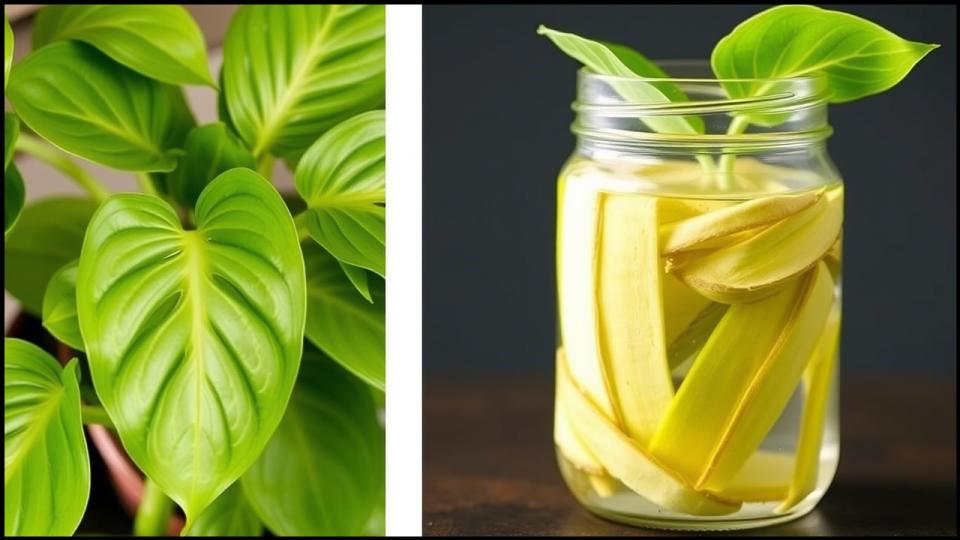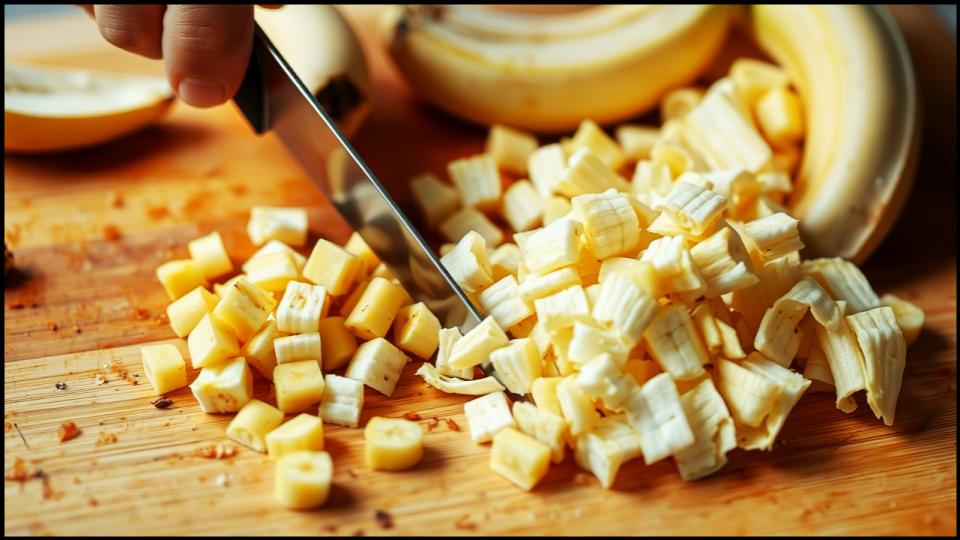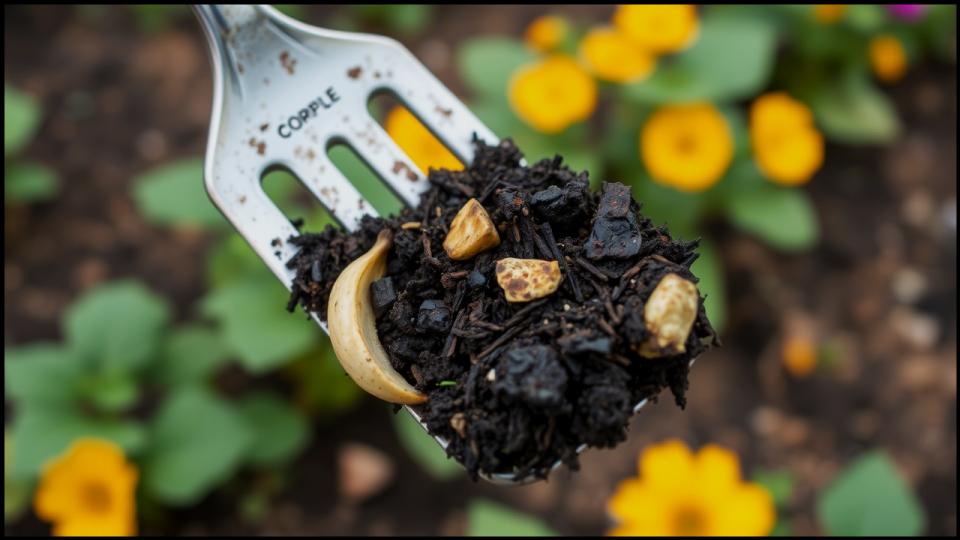It’s a trend that’s captured the imagination of houseplant enthusiasts and frugal gardeners alike: using banana water for plants. The idea is beautifully simple – soak banana peels in water, and voilà, a nutrient-rich tonic to drench your cherished greenery. But does this homemade brew truly live up to its glowing reputation for boosting blooms and fortifying foliage? We’re going to explore the science, sift through the anecdotal claims, and I’ll share some insights from my own years of cultivating everything from delicate orchids to robust vegetable gardens. By the end, you’ll understand exactly what banana water can (and can’t) do for your plants, and how to best harness any potential benefits.

Key Insights on Banana Water
Here’s what you need to know about using banana water for your plants:
- Potassium Potential: Banana peels do contain potassium, which can leach into water. Potassium is vital for overall plant vigor, flower and fruit development.
- Limited Nutrient Transfer: While peels contain other nutrients like calcium and magnesium, these are not readily water-soluble in significant amounts from a simple soak.
- Not a Complete Fertilizer: Banana water is not a balanced source of all essential plant nutrients, especially nitrogen and phosphorus, which are crucial for growth.
- Composting is King: Composting banana peels is a far more effective way to return their full spectrum of nutrients to your garden soil.
- Use with Care: If you try it, use fresh, diluted banana water promptly to avoid pests and mold.
What Exactly Is Banana Water?
At its core, banana water is the liquid created by steeping one or more banana peels in water for a period, typically ranging from a few hours to a couple of days. The premise is that the water will absorb beneficial nutrients from the peels, creating a mild, homemade liquid fertilizer. It’s a wonderfully zero-waste idea, aiming to repurpose kitchen scraps for the good of our green companions – a concept I always applaud in principle. Many gardeners, myself included, are always looking for organic gardening tips that are both effective and sustainable.
The methods vary: some chop the peels, some use them whole; some use a short soak, others prefer a longer infusion. Regardless of the specific technique, the goal remains the same: to create a nutrient-rich elixir for healthier, happier plants.
The Allure of Banana Water for Plants: What’s the Theory?
The primary appeal of banana water for plants lies in the nutritional profile of the banana peel itself. Bananas are famously rich in potassium, and their peels are no exception. This is where the main excitement stems from.

The Potassium Promise
Potassium is a macronutrient essential for plant health, often denoted by the “K” in N-P-K fertilizer ratios. It plays a crucial role in several plant functions:
- Enzyme Activation: Potassium activates enzymes involved in photosynthesis and respiration.
- Water Regulation: It helps control the opening and closing of stomata, pores on the leaf surface that regulate water loss and gas exchange.
- Flowering and Fruiting: It’s vital for producing and transporting sugars, which fuel flower and fruit development. Indeed, plants deficient in potassium for plants may show poor flowering or small fruit.
- Disease Resistance & Vigor: Adequate potassium strengthens plant cell walls, improving overall resilience.
The theory is that by soaking the peels, this valuable potassium, along with other trace minerals, will dissolve into the water, making it readily available for plant uptake. Many gardeners I’ve spoken with over the years are particularly hopeful that this will give their flowering and fruiting plants an extra boost.
Other Potential (But Often Overstated) Nutrients
Besides potassium, banana peels also contain calcium, magnesium, phosphorus, and small amounts of other micronutrients. Proponents of banana water suggest that these, too, become part of the “tea.” While these nutrients are undeniably present in the peel, their solubility in water, especially during a relatively short soaking period, is a key factor we need to examine. For example, phosphorus, while present, isn’t as readily leached into water as potassium.
The Science-Backed Truth About Banana Water for Plants
So, what does horticultural science say about the efficacy of banana water for plants? While the enthusiasm is infectious, we need to look at what’s realistically happening at a chemical level.
What Nutrients Actually Make It In?
Research and horticultural understanding confirm that potassium is indeed water-soluble. This means some amount of potassium will leach from the banana peels into the surrounding water. However, the actual concentration of potassium, and especially other nutrients, in the resulting banana water can be quite low.
According to a study by the University of Queensland, while banana peels are a good source of potassium (around 422mg per banana on average for the fruit, with peels also being rich), the amount transferred to water in a simple soak is variable and often modest. Other vital nutrients like phosphorus, calcium, and magnesium are much less soluble in plain water and are more effectively broken down and made available to plants through the composting process, where microorganisms work their magic. As I often remind fellow gardeners, what’s in the material isn’t always what’s available to the plant through a simple infusion.
Is It Enough to Make a Difference?
This is the million-dollar question. While your banana water will contain some potassium, it’s generally not concentrated enough to act as a significant fertilizer, especially for plants with high nutrient demands or those showing clear signs of deficiency. Think of it more as a very mild, occasional supplement rather than a cornerstone of your plant nutrition strategy.
A common mistake I see is gardeners relying solely on homemade remedies like banana water for plants and then wondering why their plants aren’t thriving. It’s often because the plants simply aren’t getting the full spectrum or adequate quantity of nutrients they need for robust growth. For instance, nitrogen, crucial for leafy growth, is largely absent in banana water.
My Experience with “Miracle” Garden Solutions
In my own extensive gardens, I’ve experimented with countless “miracle” solutions over the decades. While some traditional remedies have a firm basis in science, others, like relying heavily on banana water as a primary fertilizer, often fall into the category of “more hope than happening.” It’s lovely to think we can create powerful plant food so easily, but nature’s processes for nutrient cycling, like composting, are typically more complex and effective for a reason.
Potential Downsides and Considerations of Using Banana Water
While generally mild, there are a few potential hiccups to be aware of when using banana water for plants:
- Attracting Pests: Sugars remaining in the banana peels or the liquid itself can attract fruit flies, fungus gnats, and ants. This is especially true if the solution is left to sit for too long or if fruit pulp is included. I always advise using it fresh and ensuring no fruit bits are left behind.
- Mold and Unpleasant Odors: If banana water is stored for more than a day or two, especially in warmer conditions, it can begin to ferment and develop mold or an off-putting smell. Your plants (and your nose) won’t thank you for that!
- Nutrient Imbalance: Relying solely on banana water could theoretically lead to an imbalance if it provides some potassium but not enough of other essential nutrients. Plants, like us, need a balanced diet.
- Pesticide Residues: If you’re using conventional (non-organic) bananas, there’s a small chance that pesticide residues on the peels could leach into the water. While likely minimal, it’s a consideration for those strictly practicing organic gardening tips. Washing peels thoroughly or using organic bananas can mitigate this.
Better Ways to Boost Your Plants with Banana Power
If you’re keen on using your banana peels to benefit your garden – and I encourage you to! – there are more consistently effective methods than just soaking them.
Composting Banana Peels: The Gold Standard
This is, by far, the most horticulturally sound way to utilize banana peels. When added to a compost pile or bin, banana peels decompose fully, releasing their potassium, phosphorus, calcium, magnesium, and other micronutrients in a form that plants can readily use. The resulting compost will improve soil structure and provide a slow-release, balanced source of nourishment. In my experience, well-made compost is the true black gold for any garden.
How to Compost Banana Peels:
- Chop them up: Smaller pieces decompose faster.
- Bury them: Add them to your compost bin or pile, ensuring they are covered with other “brown” materials (like leaves or cardboard) to deter pests and balance the carbon-to-nitrogen ratio.
- Vermicomposting: Worms love banana peels (in moderation). If you have a worm farm, they’ll quickly convert peels into nutrient-rich castings.

Balanced Organic Fertilizers
For a reliable nutrient boost, especially if your plants are showing signs of deficiency or have high feeding requirements (like fruiting vegetables or heavy-flowering annuals), a good quality, balanced homemade plant fertilizer (if you make your own multi-ingredient compost tea) or a store-bought organic fertilizer is often a better choice. These products are formulated to provide a specific N-P-K ratio and often include essential micronutrients. Look for OMRI (Organic Materials Review Institute) listed products if you’re gardening organically.
Other Kitchen Scraps with Proven Benefits
While banana water is of debatable significance, other kitchen scraps have more established uses:
- Coffee Grounds: Used sparingly and dug into the soil or composted, they can add organic matter and small amounts of nitrogen. (Learn more about using coffee grounds in the garden from [Authoritative Source like Oregon State University Extension]).
- Eggshells: Crushed eggshells add calcium, though they break down slowly. They are best composted or dug directly into soil well in advance of planting.
If You Still Want to Try Banana Water: A Horticulturist’s Guide to Doing it Right
If you’re curious and want to experiment with banana water for plants, here’s how to do it in a way that maximizes potential (albeit small) benefits and minimizes downsides. I’d consider this a very mild tonic, not a primary fertilizer.
TOOLS AND MATERIALS BOX
- Banana Peels: 1-2 fresh peels (preferably organic and well-washed)
- Water: 1-2 quarts (approx. 1-2 liters) of clean, preferably non-chlorinated water (let tap water sit out for 24 hours)
- Jar or Container: A clean glass jar or pitcher with a lid
- Knife/Cutting Board: (Optional) for chopping peels
- Strainer or Sieve: To remove peel remnants
The Chopping Method
- Prepare Peels: Wash your banana peels thoroughly. For quicker infusion, chop them into smaller, 1-inch pieces. I’ve found this slightly increases the surface area for leaching.
- Soak Peels: Place the chopped peels in your jar and cover them with water.
- Steep: Cover the jar and let it sit at room temperature for 24-48 hours. Avoid steeping for longer, as it can encourage mold or fermentation.
- Strain: Strain the liquid to remove all peel pieces. This is crucial to prevent pests and mold when you apply the water.
- Dilute (Recommended): Dilute the banana water with an equal part of fresh water before applying, especially for sensitive plants or seedlings. It’s always better to err on the side of caution with homemade concoctions.
The Soaking Method (Whole Peels)
This is simpler but may result in an even milder infusion.
- Prepare Peels: Wash 1-2 banana peels.
- Soak Peels: Place the whole peels in your jar and cover them with water.
- Steep: Let it sit for 48 hours, agitating the jar once or twice a day.
- Remove Peels: Remove and discard (preferably compost!) the peels.
- Dilute: Again, I’d recommend diluting the resulting liquid 1:1 with fresh water.
Application Tips
- Use Freshly: Apply the banana water to your plants immediately after preparing and diluting it.
- Water at the Base: Pour it directly onto the soil around the base of your plants, avoiding the foliage where moisture can sometimes encourage fungal issues.
- Frequency: Don’t overdo it. Once every 2-4 weeks is more than sufficient, treating it as a minor supplement, not a replacement for regular watering or balanced feeding. In my garden, I’d use something like this very sparingly, if at all, favoring compost.
- Observe Your Plants: Pay attention to how your plants respond. If you notice any negative signs (like pests or mold), discontinue use.
The Final Peel: Encouragement and Next Steps
So, is banana water for plants the secret to a bountiful garden or a vibrant indoor jungle? While it’s a charming idea and a wonderfully frugal way to think about repurposing kitchen scraps, it’s not the potent plant food many hope it to be. The small amount of potassium it provides is unlikely to make a dramatic difference for most well-cared-for plants.
My advice, as a long-time gardener who values both tradition and science, is to embrace the spirit of resourcefulness that banana water represents but channel it into the proven powerhouse of composting. That’s where your banana peels – and a host of other kitchen scraps – can truly transform into black gold for your garden.
Feel free to experiment with banana water if you’re curious; it’s a largely harmless endeavor if done correctly. But for truly nourishing your plants and building healthy soil, focus on balanced organic fertilizers, rich compost, and understanding the specific needs of your green companions. Now, you’re equipped with the knowledge to make the best choices for your beautiful, thriving garden!
